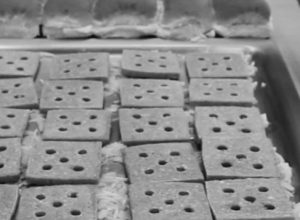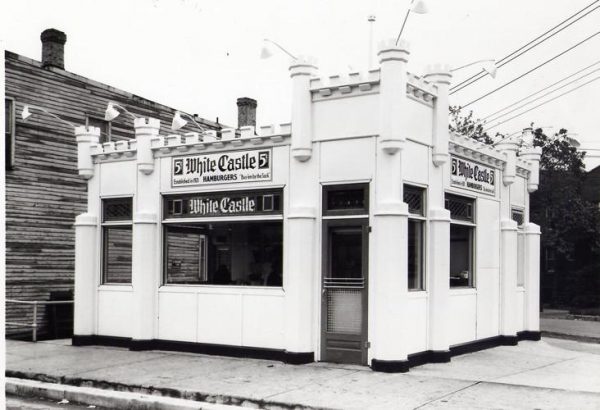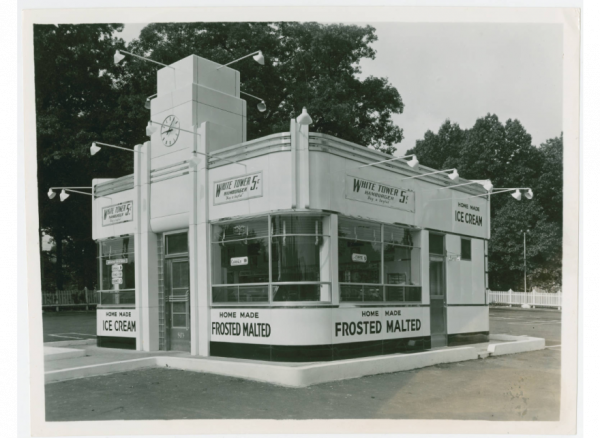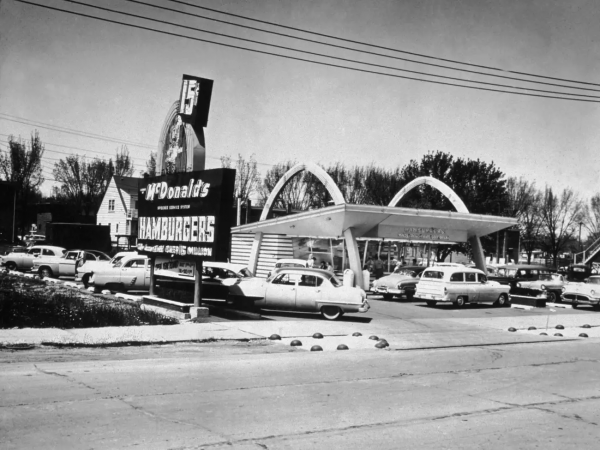White Castle has its own take on fast food hamburgers. For starters, the patties are square, with five holes in each patty. And they’re small, too –- two-and-a-half inch sliders. Just big enough to fit into the palm of your hand. And since they’re steamed on a bed of onions, everything is infused with this very specific onion-esque flavor.
 Today, White Castles can be hard to find, depending on where you live. But KCUR’s Mackenzie Martin, a producer at A People’s History of Kansas City, says that it’s time to stop thinking of White Castle as a semi-obscure cultural punchline, because over a century ago, White Castle invented something that became so important and all-encompassing that, today, it touches pretty much every person in America. Sometimes several times a day. Something that, in other countries, has almost come to define American culture: it has a strong claim to being the first fast-food restaurant.
Today, White Castles can be hard to find, depending on where you live. But KCUR’s Mackenzie Martin, a producer at A People’s History of Kansas City, says that it’s time to stop thinking of White Castle as a semi-obscure cultural punchline, because over a century ago, White Castle invented something that became so important and all-encompassing that, today, it touches pretty much every person in America. Sometimes several times a day. Something that, in other countries, has almost come to define American culture: it has a strong claim to being the first fast-food restaurant.
 Before McDonald’s, Burger King, or combination Pizza Hut & Taco Bell, there was White Castle. At first, they didn’t even serve something we’d recognize as a burger — more like meatballs on bread. But in the early 1900s, the burger emerged, and White Castle was on top of the trend.
Before McDonald’s, Burger King, or combination Pizza Hut & Taco Bell, there was White Castle. At first, they didn’t even serve something we’d recognize as a burger — more like meatballs on bread. But in the early 1900s, the burger emerged, and White Castle was on top of the trend.
Walt Anderson launched his first burger-serving joint in Wichita, Kansas, which, as it turned out, was the perfect place to set America on its burger journey. In the early 1900s, immigration from Europe and Latin America, urban migration from farms, and the Kansas oil boom brought in thousands of laborers all looking for a fast, cheap meal.
 The biggest obstacle at the time was that Americans were (understandably) skeptical of ground beef. Upton Sinclair’s famous The Jungle depicted working (and meat) conditions in ways that would make anyone’s stomach turn, and contributed to the wariness of the public with respect to processed meats. Walt was well-aware of the stigma, so he already had fresh beef delivered twice a day and even ground the meat in front of customers. In 1921, they debuted a new naming and branding concept with a very scientific sounding name: the White Castle System of Eating Houses.” … “White” to signify purity and “Castle” to signify strength and permanence.
The biggest obstacle at the time was that Americans were (understandably) skeptical of ground beef. Upton Sinclair’s famous The Jungle depicted working (and meat) conditions in ways that would make anyone’s stomach turn, and contributed to the wariness of the public with respect to processed meats. Walt was well-aware of the stigma, so he already had fresh beef delivered twice a day and even ground the meat in front of customers. In 1921, they debuted a new naming and branding concept with a very scientific sounding name: the White Castle System of Eating Houses.” … “White” to signify purity and “Castle” to signify strength and permanence.
Billy Ingram, who became a co-owner of White Castle, saw to it that the theme of solidity and safety was realized on all levels. Every restaurant would soon be made out of white porcelain-enameled steel, making the exterior extra shiny and easy to clean.
Employees had to wear clean white shirts, pants, and aprons. Hair was to be covered by a white paper cap. Fingernails were to be kept clean. And elaborate jewelry and wristwatches were strictly prohibited.
White Castle also made its restaurants accessible, strategically building near factories, and later: college campuses. And during a time when African Americans couldn’t travel safely around the country or freely enter most restaurants, the franchise was an exception.
Throughout the 1920s and 30s, the White Castle burger empire expanded out from Wichita rapidly. But White Castle would eventually encounter the problem suffered by every truly great, innovative, groundbreaking company: copycats. Soon there was White Hut, White Palace, White Tower, Little Kastle, all capitalizing on the trend.
White Castle ended up suing one of the biggest imitators and winning a large payout, but ultimately it was a game of legal whack-a-mole. It was impossible to go after everyone. The reality, too, was that the unique dining experience Walt and Billy started selling back in 1921 was becoming commonplace. In a sense, there was nothing unique for them to sell that wasn’t also offered by their competitors.
And then McDonalds was founded in San Bernardino, California in 1940. That’s 20 years after White Castle. And they had some advantages, even as latecomers. White Castle had placed its restaurants near factories, downtowns and colleges. But McDonald’s came of age during the building of the interstate and the rise of the suburb, and adapted accordingly. Above all, it had one critical advantage: McDonalds was willing to franchise its business rather than own and develop each new location. Today, there are now more than 40,000 McDonald’s worldwide. Meanwhile, there are fewer than 400 White Castles – mostly in the New York area and the Midwest – just a blip by fast food standards.
These days, White Castle might not have the ubiquity of other fast food chains, but it does have a cult following. In some ways, the fact that you can’t always find one nearby now actually works to their advantage and helps them grow their fanbase. When White Castle opened up a new location in Orlando, Florida in 2020 — customers camped out overnight and waited in line for six hours! And, for those who just can’t wait that long, there’s also a version of their favorite slider in the frozen food aisle. So for fans, there are still ways to get that strange mini-burger fix.
Big shout out to KCUR and special thanks to the authors of Drive-Thru Dreams: A Journey Through the Heart of America’s Fast-Food Kingdom and Selling ’em by the Sack: White Castle and the Creation of American Food. Get both books via the links above, and listen to KCUR here.








Leave a Comment
Share